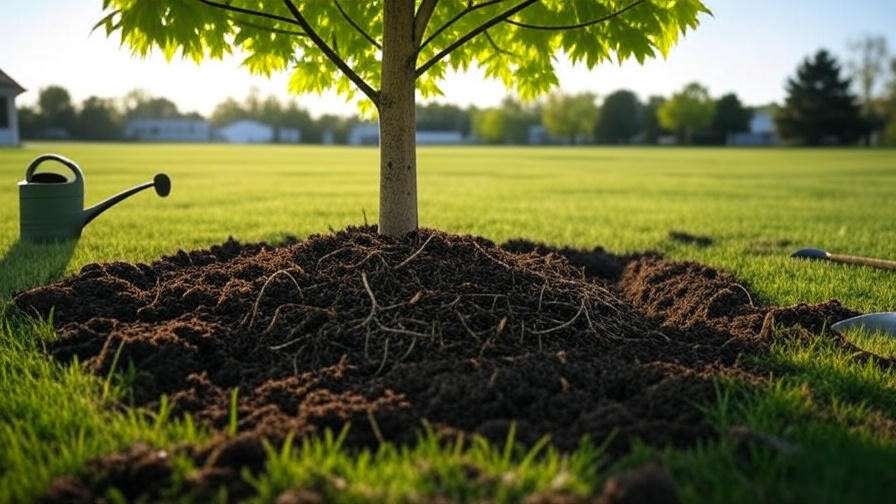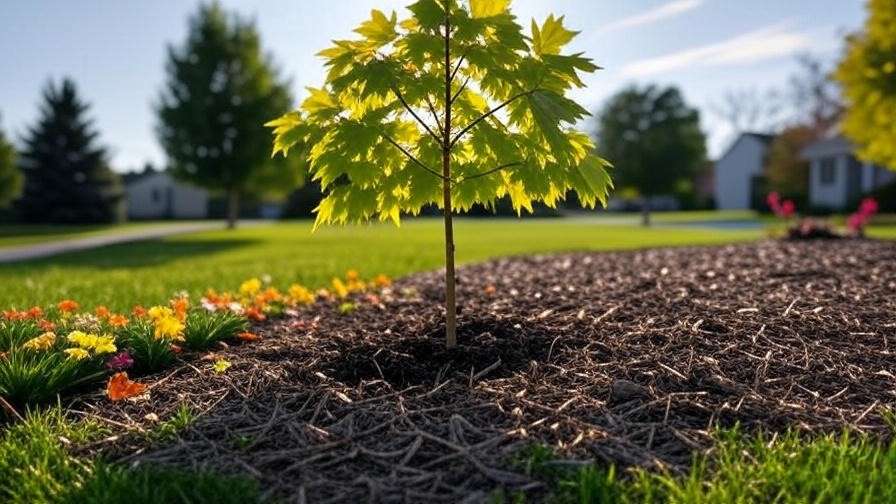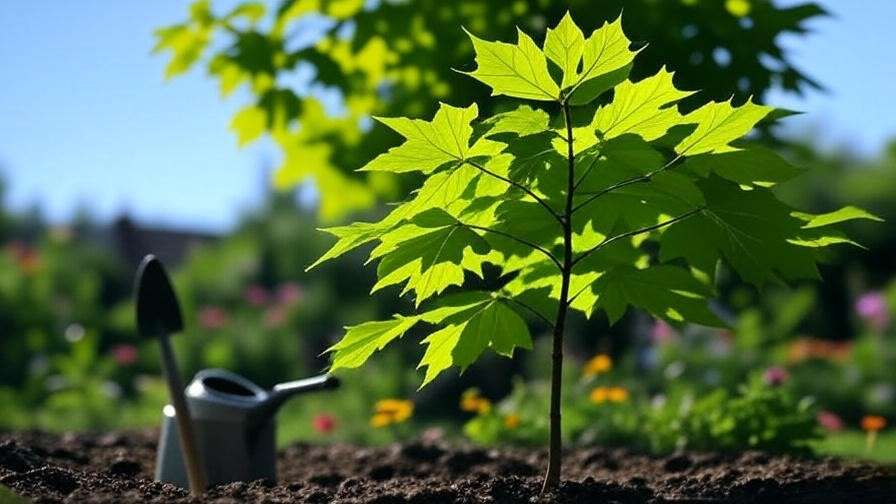Imagine standing beneath a towering maple tree, its vibrant leaves painting the sky in shades of crimson and gold, offering cool shade and a whisper of nature’s beauty. Now, picture nurturing a maple tree sapling into that majestic giant right in your own backyard! Whether you’re a new gardener or a seasoned plant enthusiast, growing a maple tree sapling is a rewarding journey that transforms your landscape and supports the environment. But young maples need special care to thrive, and mistakes can stunt their growth or worse. As a horticulturist with over a decade of experience in tree cultivation, I’ve guided countless saplings to maturity, and in this comprehensive guide, I’ll share expert tips to ensure your maple tree sapling flourishes. From planting to long-term care, you’ll learn everything needed for vibrant growth and a healthy tree. Let’s dig in! 🌿
H2: Understanding Maple Tree Saplings 🌿
H3: What Makes Maple Tree Saplings Unique?
Maple trees, belonging to the Acer genus, are beloved for their stunning foliage, sturdy wood, and ecological benefits. Maple tree saplings are young trees, typically 1-3 years old, in their critical early growth phase. Popular species include sugar maple (Acer saccharum), red maple (Acer rubrum), and silver maple (Acer saccharinum), each with unique traits. Sugar maples, for instance, are prized for their sap, which can be tapped for maple syrup, while red maples dazzle with fiery fall colors. Saplings are delicate, requiring careful attention to establish strong roots and a healthy canopy. Their growth rate varies—sugar maples grow slowly (1-2 feet per year), while silver maples are faster (2-3 feet annually). Understanding these traits helps tailor care to your sapling’s needs.
H3: Benefits of Growing a Maple Tree Sapling
Planting a maple tree sapling offers more than just aesthetic appeal. These trees enhance your landscape with vibrant seasonal colors, from spring greens to autumnal reds and oranges 🎨. Mature maples provide shade, reducing cooling costs, and act as natural privacy screens. Ecologically, they sequester carbon, improve air quality, and support wildlife like birds and pollinators. For those with sugar maples, there’s the added perk of potential syrup production 🍁. Investing time in a sapling now yields decades of beauty and environmental benefits, making it a rewarding endeavor for any homeowner or gardener.
H2: Choosing the Right Maple Tree Sapling 🪴
H3: Selecting a Healthy Sapling
Choosing a healthy maple tree sapling is the foundation of success. At nurseries, inspect the sapling for signs of vigor: bright, evenly colored leaves, a straight stem, and a well-developed root system. Avoid saplings with yellowing leaves, cracked bark, or roots circling tightly in the pot, as these indicate stress or poor care. Opt for saplings 2-4 feet tall, ideally 1-3 years old, as they adapt better to transplanting. Expert Tip: Purchase from reputable nurseries certified by organizations like the American Nursery & Landscape Association to ensure disease-free stock. A healthy start sets your sapling up for long-term success.

H3: Matching Maple Varieties to Your Environment
Not all maples thrive in every setting, so match your sapling to your local conditions. Sugar maples flourish in USDA hardiness zones 3-8, preferring cooler climates and well-drained, loamy soil. Red maples are more adaptable, thriving in zones 3-9 and tolerating wetter soils. Silver maples, also zones 3-9, grow quickly but need ample space due to their wide root systems. Ensure your site offers 6+ hours of daily sunlight and check soil pH (ideal range: 6.0-7.5). For small yards, consider compact varieties like the Japanese maple (Acer palmatum). Researching your local climate and soil ensures your sapling thrives.
H2: Planting Your Maple Tree Sapling 🌍
H3: When and Where to Plant
Timing and location are critical for planting a maple tree sapling. Spring and fall are ideal, as cooler temperatures reduce transplant shock and allow roots to establish before extreme heat or cold. Choose a site with full sun to partial shade (6+ hours of sunlight) and at least 20-30 feet of space from buildings or other trees to accommodate future growth. Ensure good drainage—maples dislike waterlogged soil. Avoid common mistakes like planting near underground utilities or in compacted soil, which can hinder root development. A well-chosen spot sets the stage for healthy growth.
H3: Step-by-Step Planting Guide
Follow these steps to plant your maple tree sapling correctly:
- Prepare the Site: Clear weeds and grass within a 3-foot radius. Test soil pH and amend with compost if needed to reach 6.0-7.5.
- Dig the Hole: Make it twice as wide as the root ball but no deeper. A wide hole encourages lateral root growth.
- Plant the Sapling: Place the sapling in the hole, ensuring the root flare (where roots meet the trunk) sits at soil level. Spread roots gently.
- Backfill and Water: Fill with native soil, tamping lightly to remove air pockets. Water thoroughly with 1-2 gallons to settle the soil 💧.
- Mulch: Apply a 2-3 inch layer of organic mulch (e.g., wood chips or bark) around the base, keeping it 2 inches from the trunk to prevent rot.

Mulching retains moisture, regulates soil temperature, and suppresses weeds. Water again after mulching to ensure a good start.
H2: Caring for Your Maple Tree Sapling 🌞
H3: Watering Needs
Proper watering is crucial for a maple tree sapling’s first year. Aim for 1-2 inches of water per week, adjusting for rainfall. In dry spells, water deeply every 3-4 days to encourage deep root growth. Use a soaker hose or drip irrigation for even moisture distribution, avoiding overhead watering that can promote fungal diseases. Check soil moisture by digging 2 inches down—if it’s dry, water immediately. Expert Insight: Overwatering is as harmful as underwatering, so ensure proper drainage to prevent root rot. Consistent moisture helps your sapling establish a strong foundation.

H3: Fertilizing for Growth
Fertilizing supports healthy development but should be done cautiously. In the first year, rely on the soil’s natural nutrients unless testing shows deficiencies. In spring of the second year, apply a balanced 10-10-10 fertilizer or a slow-release tree fertilizer at the manufacturer’s recommended rate (typically 1-2 pounds per 100 square feet). Spread it evenly under the canopy, avoiding direct contact with the trunk. Over-fertilizing can burn roots, so follow guidelines and test soil annually. Expert Tip: Organic compost can supplement synthetic fertilizers for sustainable nutrient release.
H3: Pruning and Training
Pruning shapes your sapling and promotes a strong structure. Prune in late winter or early spring before sap flow begins, as maples “bleed” sap if cut later. Remove dead, damaged, or crossing branches, and thin crowded areas to improve air circulation. For young saplings, focus on establishing a central leader (main trunk) by cutting back competing shoots. Use clean, sharp pruning shears to avoid tearing bark ✂️. Avoid heavy pruning in the first year to minimize stress. Proper pruning ensures a balanced, healthy canopy as your tree matures.
H2: Protecting Your Sapling from Common Threats 🛡️
H3: Pests and Diseases
Maple tree saplings are vulnerable to pests and diseases that can hinder growth if not addressed promptly. Common pests include aphids, which suck sap and cause leaf curling, scale insects that form crusty patches on bark, and Japanese beetles that chew foliage. Diseases like verticillium wilt (causing wilting and branch dieback), tar spot (black spots on leaves), and anthracnose (brown leaf lesions) can also affect saplings.
Prevention Strategies:
- Inspect leaves and stems weekly for early signs of trouble.
- Ensure proper spacing (20-30 feet) to improve air circulation and reduce fungal risks.
- Avoid overhead watering to keep foliage dry, minimizing disease spread.
Treatment Options:
- For pests, use organic solutions like neem oil or insecticidal soap, applied in the early morning or evening.
- For fungal diseases, remove affected leaves and dispose of them properly to prevent spore spread.
- If symptoms persist, consult a certified arborist for advanced treatments, such as fungicides for severe cases.
Regular monitoring and proactive care keep your sapling healthy and resilient.

H3: Environmental Stressors
Young maples face environmental challenges like drought, frost, wind, and sunscald. Drought stresses roots, causing leaf wilt, while frost can damage new growth in early spring. Strong winds may snap delicate branches, and sunscald (bark cracking from intense sunlight) is a risk in winter.
Protection Tips:
- Drought: Mulch heavily (2-3 inches) to retain soil moisture and water deeply during dry periods.
- Frost: Cover saplings with burlap or frost blankets during unexpected late frosts.
- Wind: Stake saplings only if necessary (e.g., in windy areas), using flexible ties to allow natural movement. Remove stakes after 1-2 years to avoid dependency.
- Sunscald: Wrap trunks with tree guards or burlap in late fall to shield against winter sun.
Winter Care: In colder climates (zones 3-5), add an extra 2 inches of mulch around the root zone for insulation. Protect against rodents like voles or rabbits by installing a mesh guard around the trunk base 🐿️. These measures ensure your sapling weathers environmental challenges.
H2: Long-Term Care for Thriving Maples 🌲
H3: Transitioning from Sapling to Mature Tree
As your maple tree sapling grows (years 2-5), it transitions from delicate youth to a robust young tree. Expect growth spurts—sugar maples may add 1-2 feet annually, while silver maples can grow faster. The canopy begins to fill out, and roots expand significantly. During this phase, adjust care to support long-term health:
- Watering: Reduce frequency to once every 7-10 days as roots deepen, but ensure deep watering (1-2 inches) during dry spells.
- Fertilization: Scale back to once every 1-2 years, using a slow-release fertilizer to avoid overfeeding.
- Root Monitoring: Ensure roots have space to expand without competing with nearby plants or structures.
By year 5, your sapling should resemble a small tree, with a sturdy trunk and a developing canopy. Regular care during this phase builds a foundation for decades of growth.

H3: Seasonal Maintenance Checklist
Consistent seasonal care ensures your maple thrives year-round. Use this checklist to stay on track:
- Spring 🌸: Inspect for pests and diseases. Apply fertilizer if needed. Prune dead or damaged branches before bud break.
- Summer ☀️: Monitor soil moisture and water during heatwaves. Refresh mulch to maintain a 2-3 inch layer.
- Fall 🍂: Rake and remove fallen leaves to prevent fungal buildup. Check stakes or guards and adjust as needed.
- Winter ❄️: Insulate roots with extra mulch. Wrap trunks to protect against sunscald and rodents. Inspect for storm damage after heavy snow or wind.
This routine keeps your maple healthy and prepared for each season’s challenges.

H2: Expert Tips for Success 🌟
To give your maple tree sapling the best chance at thriving, incorporate these expert insights:
- Tip 1: Install a drip irrigation system for consistent, deep watering. Set it to deliver 1-2 gallons over 1-2 hours weekly, adjusting for rainfall.
- Tip 2: Test soil annually with a home kit or through a local extension service to monitor pH and nutrient levels. Adjust with lime or sulfur if pH strays from 6.0-7.5.
- Tip 3: Stake saplings only in windy areas, using two stakes and flexible ties. Remove stakes after 1-2 years to encourage a strong trunk.
- Case Study: A homeowner in Vermont planted a sugar maple sapling in loamy soil with full sun. By following a drip irrigation schedule, mulching annually, and pruning lightly each spring, their sapling grew 8 feet in 4 years, with a vibrant canopy and no pest issues.
These tips, drawn from years of hands-on experience, maximize your sapling’s potential.
H2: Frequently Asked Questions (FAQs) ❓
Q: How long does it take for a maple tree sapling to mature?
A: Maturity varies by species. Sugar maples take 20-30 years to reach full size (60-75 feet), while red and silver maples may mature faster (15-25 years). Saplings are considered established after 3-5 years.
Q: Can I grow a maple tree sapling in a pot?
A: Yes, but only temporarily (1-2 years) and for smaller varieties like Japanese maples. Use a 15-20 gallon pot with drainage holes and well-draining soil. Transplant to the ground for long-term growth.
Q: What’s the best maple species for small yards?
A: Japanese maples (Acer palmatum) or smaller cultivars like ‘Crimson Queen’ are ideal, growing 10-25 feet tall. They thrive in partial shade and add ornamental beauty.
Q: How do I know if my sapling is getting enough water?
A: Check soil 2-3 inches deep—if it’s dry, water deeply. Wilting leaves or dry, brittle stems indicate under-watering; yellowing leaves may signal overwatering.
Q: Are maple tree saplings deer-resistant?
A: Maples are moderately deer-resistant, but young saplings are vulnerable to browsing. Use deer fencing or repellents, especially in rural areas.
H2: Conclusion: Growing Your Maple Tree Sapling with Confidence 🌼
Nurturing a maple tree sapling is a journey of patience and reward. By choosing a healthy sapling, planting it correctly, and providing consistent care—watering, fertilizing, pruning, and protecting—you set the stage for a vibrant, long-lived tree. Whether you’re dreaming of fiery fall foliage, cool summer shade, or even homemade maple syrup, your efforts today will yield beauty and benefits for decades. Start your maple tree journey with confidence, and don’t hesitate to consult a local arborist for tailored advice. Share your sapling stories or questions in the comments below, and explore our related articles on tree care for more tips! 🌟













